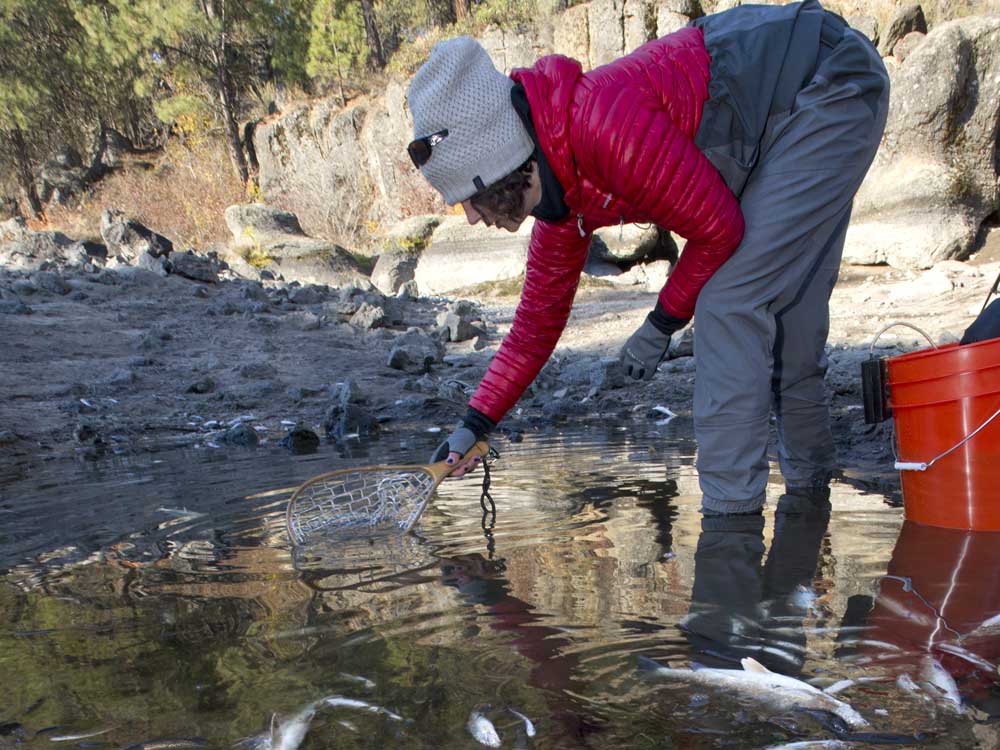Bend fishing club casting for fish rescuers
Published 11:31 am Tuesday, September 9, 2014

- Ryan Brennecke / The Bulletin file photoKim Brannock uses a net to scoop a trout from a small pool of water filled with fish in a side channel of the Deschutes River near Lava Island Falls after the water dropped and stranded hundreds of fish last year. Brannock spent the morning transporting the remaining live fish back to the main river in plastic buckets.
Hoping to avoid a repeat of last October’s fish die-off in a side channel of the Deschutes River near Bend, a local fishing group is trying to reel in volunteers now.
Volunteers would be ready to move fish from dwindling pools back into the river if they become stranded again this October, said Gabe Parr, founder of the Bend Casting Club.
“The more people we have involved the less time it will take,” Parr said Monday.
Hundreds of fish, including rainbow and brown trout, died last year in a side channel near Lava Island Falls when the Oregon Water Resources Department dropped Deschutes River flows after the end of irrigation season. The drop came as the department started to store water in Wickiup Reservoir for the next irrigation season.
Out on a run on Oct. 17, 2013, Kim Brannock of Bend spotted dead and dying fish in a shrinking pool and the next day returned with a rescue team of her husband, her young daughter and their neighbor. A pair of Oregon Department of Fish and Wildlife workers helped them move some of the fish, but most perished.
Since she discovered the dead fish, Brannock, an outdoor clothing designer and angler, joined the board of the Bend Casting Club. The club started in 2010 and is an offshoot of Trout Unlimited, a national conservation group with 150,000 members.
So far Parr said he has 15 people signed up. He hopes to have two to three teams of 20 people, about 40 to 60 people, set to help with the fish in October, if needed. People can sign up online and can choose if they want to help identify fish, load fish into buckets or haul buckets to the river.
Rugged Lava Island blocks a direct path to the main river near the location of last year’s fish kill, so last October Brannock’s crew hauled fish an eighth of a mile up the Deschutes River. If a rescue effort is needed again this year Parr said most of the volunteers would be in a bucket brigade , where people would pass buckets loaded with fish down a line formed between the side channel and the river.
“It is going to take some work,” he said. A 5-gallon bucket filled with water weighs about 40 pounds, not including any fish. The teams would also respond to other potential fish die-offs of fish between Wickiup Reservoir and Bend, Parr said, which are separated by about 60 miles of river.
Parr said he is hopeful a rescue might not be needed this year. Since last year’s die-off, conservation groups have been meeting with state water managers and irrigation district leaders to see if changes could be made to avoid a similar situation.
The Water Resources Department is considering changing how it decreases releases out of Wickiup Reservoir , said Kyle Gorman, regional manager. Rather than a continuous drop, it may ratchet flows down in increments, giving people a chance to check for stranded fish and rescue them if needed. Officials now also know when the river is low enough to cause fish to be stranded by Lava Falls — when the gauge upstream at Benham Falls hits 700 cubic feet per second or less.
“We are much, much more aware this year than we have been in the past,” Gorman said. Changing how Water Resources ramps down the river could prevent fish from being stranded even when flows go below 700 cfs at Benham Falls, he said. As of Tuesday, Central Oregon was still in the midst of irrigation season and the river at Benham Falls was flowing at more than 1,800 cfs. Come winter the river will run as low as 35 cfs.
Brannock, who in the past year also joined the board of the Deschutes River Alliance, a nonprofit focused on the health of the lower Deschutes River, said the talks since last October could prevent more fish being stranded and improve the condition of the river.
“We don’t want a bunch of fish killed each fall; that is not good for the river,” Brannock said.
— Reporter: 541-617-7812,
ddarling@bendbulletin.com






